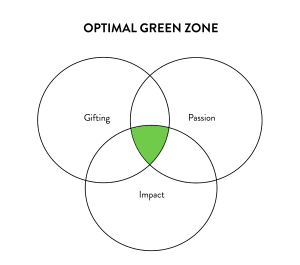
How many productive hours a day do you have in you?
It’s a more important question than you might think. When I was starting out in leadership, I might have answered that by saying eight or ten. Or twelve.
What about you? How many productive hours do you think you have in you?
Like many driven leaders, I thought I was superhuman. Pushing the pedal to the floor worked for a while – until it didn’t.
Then—also like a growing number of leaders—I hit the wall. I burned out.
When I rebuilt my leadership in the following years, I started to manage my energy, not just my time.
Here’s what I learned.
As driven and determined as I was, I really only had three to five peak hours in me every day during which my energy was high, my focus was clear, and my mind was sharp.
At first, that observation made me feel like a fraud. If I get paid for full-time work and put in eight or more hours a day, how can I only have three to five peak hours in a day?
After researching and testing this theory with other leaders I’ve trained, guess what? Most leaders have only three to five deeply productive hours in a day when their energy is at its peak. That’s it.
Most leaders have only three to five deeply productive hours in a day when their energy is at its peak. That's it. Click To TweetWhen I was writing my latest book, At Your Best, where I explain how to leverage your peak and non-peak hours, I flirted with the idea of calling the book The Three-Hour Workday (with apologies to Tim Ferriss). Obviously, that wasn’t going to fly, but often that’s how I think about my day, and I’d encourage you to think about your day too.
Here are five principles that will help you leverage your energy, especially during your peak hours. Once you master this concept, you will get far more done in your peak three hours than you realize.
It starts here by accepting that not all hours are created equal.
1. Accept that 24 Equal Hours Don’t Feel Equal or Produce Equally
You get 24 equal hours each day, but those hours don’t feel equal or produce equally.
You might bring a ton of energy to a 10 a.m. meeting, but step into the board room at 4:30 p.m., and you might struggle to stay awake and hyper-caffeinating just to make it through.
Here’s the truth…your energy waxes and wanes over the day. You’re not a robot. You’re human.
Daniel Pink points out that even physicians struggle with this. Anesthesiologists have an ‘adverse event’ about 1% of the time during 9 a.m. surgeries. At 4 p.m., the rate rises to 4.2%. In other words, you’re 400% more likely to have a problem in an afternoon procedure than in a morning procedure.
Why? Simple: Research shows even doctors have trouble focusing in the afternoon.
Most of you reading this post aren’t doing surgery. Many of you have more control over your schedule than a doctor does. This means you find yourself in this glorious space: you have a real choice in whether you co-operate with your energy levels or compete with them.
Co-operating with your energy levels is a much better strategy than competing with them.
Ironically, ignoring your energy levels (as in, pretending they don’t vary) puts you on the fast track to making you less productive.
As a leader, you get 24 equal hours each day, but those hours don't feel equal or produce equally. Click To Tweet2. Find Your Green Zone (+ Your Yellow and Red Zones)
The second step in maximizing your peak three to five hours is to divide your day into three zones: Green, Yellow, and Red.
Think of your peak 3-5 hours as your Green Zone—when your energy, focus, creativity, and great ideas flow easily and sharpest. When you’re in your Green Zone, you have enthusiasm for the tasks ahead. During those 3-5 hours each day, you’re at your best.
Your Red Zone is the opposite—it’s those 1-2 hours when you’re dragging, need caffeine to stay awake, and can’t focus deeply on anything. In your Red Zone, not only do you not produce your best work—sometimes you struggle to produce any meaningful work.
Your Yellow Zone consists of the hours in between—you are neither at your best nor your worst. You’re in the middle. You’re fine in meetings, you can produce content or plan ahead. It’s not your best work, but definitely not your worst.
Your results will differ, but my Green Zone happens between 7-11 a.m. every day, and (on good days) I get an extra hour between 1-2. My Red Zone is from 4-6 p.m. Everything else is Yellow.
Now that you know when you’re at your best, shift your workload accordingly.
Do your most important work during your Green Zone, your least important work during your Red Zone (or, alternatively, take a break), and do everything else in your Yellow Zone.
If you get your peak hours right, the rest of the hours take care of themselves.
If you don’t get your peak hours right, you almost can’t work enough to make up for mismanaging them. Plus, your stress level skyrockets.
If you get your peak hours right, the rest of the hours take care of themselves. If you don't get your peak hours right, you almost can't work enough hours to make up for mismanaging them. Plus your stress level skyrockets. Click To Tweet3. Figure Out What You’re Best At
To maximize your peak hours, you not only need to discover when you’re at your best, but what you’re best at. In other words, you must figure out what to do in your Green Zone.
The most strategic Green Zone use is to spend it on activities anchored in your gifting and passion that have a big impact on your organization’s mission.
If you Venn diagram it, it comes together like this:

Your gifting is your sweet spot—what you uniquely do best. Your passion is what you love doing. And impact refers to those things that, when done, will make the biggest difference to your mission.
When those three circles overlap, you find leadership gold. Everything becomes easier, more enjoyable, and has a bigger impact.
In my role as a senior leader, I’ve found I’ve had the most success in my Green Zone when I focus on five things:
- Casting crystal-clear vision
- Creating and delivering great content
- Crafting a healthy organizational culture
- Keep our top staff and clients aligned and relationally connected
- Ensuring we have the financial resources we need for our mission.
There are about eighty-six other things I could spend my time on, but these five produce the greatest results.
The question for you, then, is: what will produce the greatest results for you?
In your Green Zone, do that.
Once you identify your optimal Green Zone focus, you’ll not only enjoy your work more, you’ll see much better results.
4. Stop Reacting To Everything and Everyone
The biggest obstacles to maximizing your peak three to five hours daily can be summarized in two words: everything and everyone.
Knowing you have three to five productive hours in a day and using those three to five hours effectively are very different things.
Far too many days go down in flames because you have a to-do list that never becomes a ‘done’ list. Meanwhile, all kinds of things that weren’t on your to-do list got done.
Far too many days go down in flames because you have a to-do list that never becomes a 'done' list. Meanwhile, all kinds of things that weren't on your to-do list got done. Click To TweetIf you look at it honestly, the “oh my goodness, what happened to my day?” phenomenon you and I experience is not a mystery. Nine times out of ten, you simply spent your day reacting to everything that came your way.
If you don’t protect your Green Zone, you’ll accomplish everyone else’s priorities and never accomplish yours.
So, protect those hours. Work in a quiet environment, turn off all notifications on your devices, and double down.
The biggest obstacles to using your peak 3-5 hours each day optimally can be summarized in two words: everything and everyone. Click To Tweet5. Let Three to Five Focused Hours Replace Your Normal Ridiculous Hours
The reason you take your stress home, work ridiculous hours and feel like you’re never finished is usually because your most important work didn’t get done when you were working.
When your most important work never gets done, you never feel done. Which causes you to work all the time.
Ask any preacher whose sermon is still ‘in development’ Friday afternoon, any CEO who is unclear on strategy for the next quarter, or any manager who hasn’t dealt with their toughest team issues if they can relax. They’ll look at you like you have three heads.
When you realize you’ve got three to five hours to accomplish your most significant work, and you focus deeply enough to do it, everything else becomes so much easier. Doing that five days a week means you’ll not only catch up, but you’ll also likely get ahead.
When I get my major content done, I almost feel like I can call it a day. I don’t–I have meetings and other things that are less important to do. But the big stuff is done.
This means when I’m in a meeting, I’m focused on the meeting, not thinking about other things. It means when I’m relaxing, I can relax. When I’m home, I’m home.
Having only three to five productive hours in a day might make you feel like you’re losing, but when you leverage them, you’ll start winning in ways you never imagined.
I outline the strategy in detail in At Your Best: How to Get Time, Energy, and Priorities Working In Your Favor. If you want to learn more, here’s the link.
When your most important work never gets done, you never feel done. Which causes you work all the time. Click To Tweet